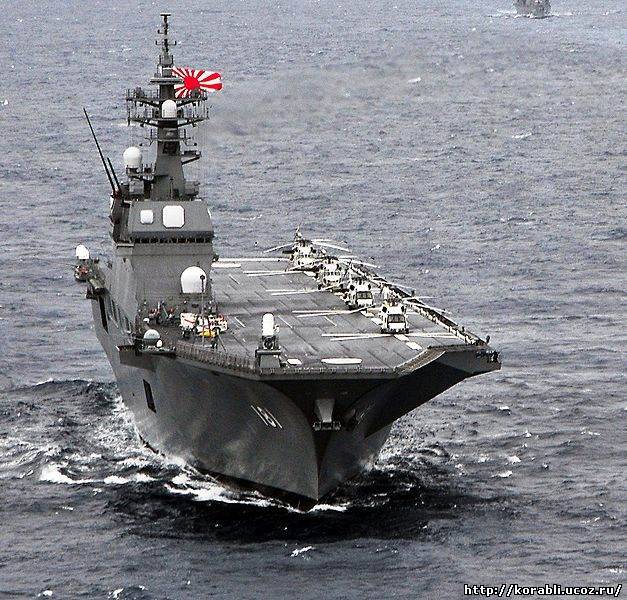
Japanese helicopter destroyers
Japanese helicopter destroyers
The largest ships of the Japanese Naval Self-Defense Force are specific units classified in part as destroyer helicopters. The purely political labeling suited the representatives of the first generation of these constructions, which had already been removed. Currently, a new generation of this class is next in line - the result of Japanese experience, technical developments, a regional arms race and geopolitical changes in Far East Asia. This article presents all eight units that formed and still form the basis of the surface escort forces of the Self-Defense Forces.
The birth of the concept
As both world wars have shown, an island nation with even a large naval force can be easily paralyzed by submarine operations. During the Great War, Imperial Germany tried to do this, looking for a way to defeat Great Britain - the technical level of the time, as well as London's finding of corrective methods, foiled this plan. In 1939-1945, the Germans were again close to delivering a decisive strike with submarines - fortunately, it ended in a fiasco. On the other side of the globe, the US Navy carried out similar actions against the naval forces of the Empire of Japan. Between 1941 and 1945, American submarines sank 1113 Japanese merchant ships, accounting for nearly 50% of their losses. This effectively slowed down hostilities and communication between the Japanese islands, as well as areas on the Asian continent or in the Pacific Ocean. In the case of the Land of the Rising Sun, it is also important that the various products needed to support industry and society are imported by sea - energy resources are among the most important. This constituted a significant weakness of the country in the first half of the XNUMXth century and at the present time. It is not surprising, therefore, that ensuring security at sea lanes has become one of the main tasks of the Japan Maritime Self-Defense Force since its inception.
Already during the Great Patriotic War, it was noticed that one of the best ways to deal with submarines, and therefore the main threat to communication lines, was the interaction of the duo - a surface unit and aviation, both ground-based and warships that climbed aboard.
While the large fleet carriers were too valuable to be used to cover convoys and trade routes, the British experiment in converting the merchant ship Hanover into the role of an escort carrier began the mass construction of the class. This was one of the keys to the success of the Allies in the battle for the Atlantic, as well as in operations in the Pacific Ocean - in this theater of operations, the services of ships of this class were also used (to a limited extent) by Japan.
The end of the war and the surrender of the Empire led to the adoption of a restrictive constitution that, among other things, prohibited the construction and operation of aircraft carriers. Of course, in the 40s, no one in Japan thought about building such ships, at least for economic, financial and organizational reasons. The beginning of the Cold War meant that the Americans began to convince the Japanese more and more of the creation of local police and order forces, aimed, in particular, at ensuring the security of territorial waters - finally created in 1952, and two years later transformed into the Naval Forces self-defense (English Japan Maritime Self-Defense Force - JMSDF), as part of the Japan Self-Defense Forces. From the very beginning, the main tasks facing the marine part were to ensure the safety of communication lines from sea mines and submarines. The core was made up of anti-mine and escort ships - destroyers and frigates. Very soon, the local shipbuilding industry became the supplier of the units, which cooperated with American companies that supplied, on the basis of the approval of the State Department, on-board equipment and weapons. These were supplemented by the construction of land-based naval aviation, which was to consist of numerous patrol squadrons with anti-submarine capabilities.
For obvious reasons, it was not possible to build aircraft carriers - the technological evolution of the Cold War era came to the aid of the Japanese. In order to effectively fight, first of all, with Soviet submarines, Western countries (primarily the United States) began work on using helicopters for this type of operation. With VTOL capabilities, rotorcraft do not need runways, but only a small space on board and a hangar - and this allowed them to be placed on warships the size of a destroyer / frigate.
The first type of anti-submarine helicopter that could operate with Japanese ships was the Sikorsky S-61 Sea King - it was built under license by Mitsubishi factories under the designation HSS-2.
The heroes of this article form two generations, the first of them (already removed from service) included the types of Haruna and Shirane, and the second Hyuuga and Izumo. They are designed to work with airborne helicopters to combat underwater targets, the second generation has advanced capabilities (more on that later).

